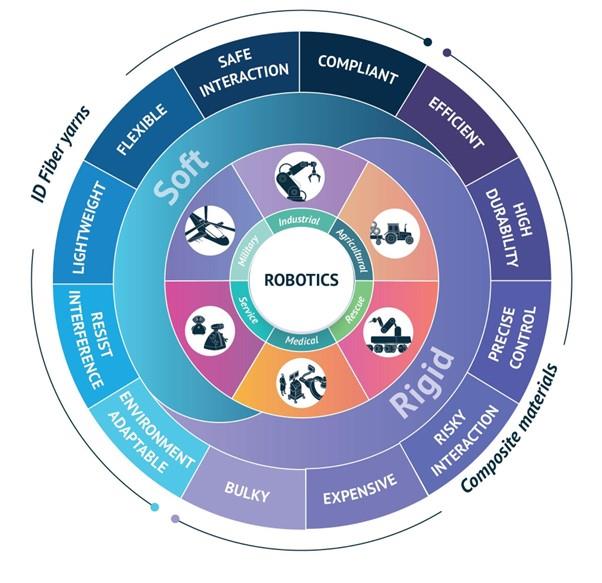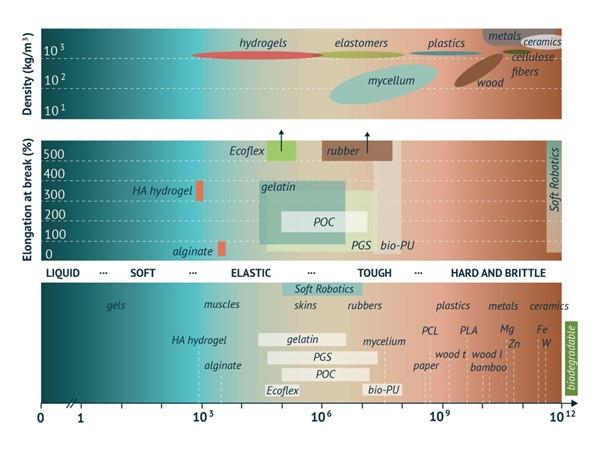Additional challenges that are connected to materials science include the design of bio-hybrid and bioinspired robots, taking inspiration from living organisms to create multifunctional and autonomous systems. In addition, the adaptability of robots to extreme and complex environments is related to the mechanical and self-healing properties of innovative robotics materials.

Advantages and disadvantages of soft robotics vs. traditional robotics materials. From[2]
To understand the rapidly advancing field of robotics materials, it is necessary to introduce a distinction between traditional robotics and soft robotics. Traditional robotics relies on mechatronic systems for the design of robots. These robots are typically powered by electromechanical motors and are assembled from independent components and materials, each performing a separate function (actuation, sensing, structural). Traditional robotics is based on rigid materials, such as steel, aluminium, hard plastic, alloys, and composite materials.
On the other hand, soft robotics aims to integrate different functions, including actuation, sensing, adaptivity, and locomotion, into one single material. In this context, soft robots take advantage of smart and multi-functional materials, such as elastomers, gels, fabrics, and biological materials, which allow the body of the robot to comply with the surrounding environment.[3]
A new generation of robotics materials
Compared to traditional robotics, soft robotics is based on a new generation of deformable, flexible, and smart materials. One of the main classes of soft robotics materials is elastomeric materials, such as natural and synthetic rubbers, silicones, like polydimethylsiloxane (PDMS), and soft composites. Elastomers are mechanically compliant and have high elastic modulus so that they can recover their shape even after very significant deformations.[5]

Mechanical properties of materials for soft robotics. From [6]
Another class of evolving robotics materials is smart materials. These materials are intrinsically multifunctional, combining sensing, actuation, and structural purposes in a single component. Smart materials can change their shape in response to several stimuli including electric fields, temperature, light, and pH.[3]
Among smart materials, electromechanically active polymers (EAPs), also known as artificial muscles, are deformed in response to applied voltages. In soft robotics, they are used to produce actuators by sandwiching the polymer between two compliant electrodes.[8] Shape-memory polymers, on the other hand, are programmed to recover a specific shape upon heating. These have interesting applications in the aerospace and biomedical fields.[3]
Fabricating soft-bodied robots
Compared to traditional robots, the large-scale fabrication of soft robots is still in its infancy. In recent years, however, new manufacturing possibilities have emerged. Since soft robots are mostly polymer-based, there are two main approaches to their manufacture, namely, cast-moulding, and additive manufacturing.
Cast moulding is commonly used for soft robots that do not require elaborate structures. In the case of silicone rubbers and other catalysed polymers, crosslinking takes place from the mixing of two components; therefore, degassing the polymer mixture before hardening is crucial to prevent defects in the final component. If traditional moulding is not sufficient, approaches such as dip-coating and rotational moulding are effective to shape complex internal volumes.[9]
Additive manufacturing (AM), also known as 3D printing, is the easiest way to shape highly elaborate components. It is based on the deposition of small volumes of materials to create the desired shape. Although it was originally designed only for hard, thermoplastic polymers, in recent years AM has been extended to soft materials such as elastomers and hydrogels, becoming one of the most promising manufacturing approaches for soft robots. In this context, AM techniques have been applied to smart materials, with an approach known as 4D printing.[10] When exposed to specific environmental conditions, 4D-printed components morph into a pre-programmed shape. Read more about the impact of AM in the manufacturing chapter.
Applications for soft robotics
The expected compound annual growth rRate (CAGR) for the soft robotics industry between 2022 and 2027 amounts to 35.1%, with North America as the largest market. This testifies to the growing interest in soft robotics solutions in various fields, with medical and surgical applications predicted to register the highest growth.[13]
In the biomedical field, soft robotics offer unprecedented opportunities to design smart prosthetic limbs at a fraction of the cost required for traditional devices. For example, a soft robotic elastomeric hand (see image below) actuated via a pneumatic system, was recently designed to provide real-time tactile feedback to patients.[14] Soft robotics may also enable growth in minimally invasive surgery (MIS), providing quicker and safer surgical procedures without damaging surrounding tissues.

Inflatable robotic hand with tactile feedback. Source: MIT news
Another promising field for soft robotics is the production of soft grippers for handling fragile objects. With more and more industries, including the food industry, progressing towards automation, a new generation of versatile robotic grippers is being developed. Due to their light weight, dexterity, and robustness, soft-bodied robots are also a promising technology for space applications.[15]
Overall, the intersection between robotics and materials science offers great opportunities for diverse fields of technology. Thanks to the development of smarter materials and advanced manufacturing techniques, a new generation of soft-bodied, bio-inspired, and sustainable robots are on the rise.

References
1.Yang G-Z, Bellingham J, Dupont PE, Fischer P, Floridi L, Full R, et al. The grand challenges of Science Robotics [Internet]. Vol. 3, Sci. Robot. 2018. Available from: http://robotics.sciencemag.org/
2.Fu C, Xia Z, Hurren C, Nilghaz A, Wang X. Textiles in soft robots: Current progress and future trends. Vol. 196, Biosensors and Bioelectronics. Elsevier Ltd; 2022.
3.Mazzolai B, Mondini A, Del Dottore E, Margheri L, Carpi F, Suzumori K, et al. Roadmap on soft robotics: multifunctionality, adaptability and growth without borders. Multifunct Mater. 2022 Sep 1;5(3).
4.Lan X, Zhao X. Application of carbon fiber composite materials in the field of industrial robots. In: ACM International Conference Proceeding Series. Association for Computing Machinery; 2019. p. 310–5.
5.Gariya N, Kumar P. A review on soft materials utilized for the manufacturing of soft robots. In: Materials Today: Proceedings. Elsevier Ltd; 2021. p. 11177–81.
6.Hartmann F, Baumgartner M, Kaltenbrunner M. Becoming Sustainable, The New Frontier in Soft Robotics. Vol. 33, Advanced Materials. John Wiley and Sons Inc; 2021.
7.Wehner M, Truby RL, Fitzgerald DJ, Mosadegh B, Whitesides GM, Lewis JA, et al. An integrated design and fabrication strategy for entirely soft, autonomous robots. Nature. 2016;536(7617):451–5.
8.Bar-Cohen Y, Anderson IA. Electroactive polymer (EAP) actuators—background review. Mech Soft Mater. 2019 Dec;1(1).
9.Schmitt F, Piccin O, Barbé L, Bayle B. Soft robots manufacturing: A review. Vol. 5, Frontiers Robotics AI. Frontiers Media S.A.; 2018.
10.Sydney Gladman A, Matsumoto EA, Nuzzo RG, Mahadevan L, Lewis JA. Biomimetic 4D printing. Nat Mater. 2016;15(4):413–8.
11.Rossiter J, Winfield J, Ieropoulos I. Here today, gone tomorrow: biodegradable soft robots. In: Electroactive Polymer Actuators and Devices (EAPAD) 2016. SPIE; 2016. p. 97981S.
12.Terryn S, Langenbach J, Roels E, Brancart J, Bakkali-Hassani C, Poutrel QA, et al. A review on self-healing polymers for soft robotics. Vol. 47, Materials Today. Elsevier B.V.; 2021. p. 187–205.
13.Soft Robotics Market - Growth, Trends, Covid-19 Impact, and Forecasts (2022-2027) [Internet]. Available from: https://www.mordorintelligence.com/industry-report...
14.Gu G, Zhang N, Xu H, Lin S, Yu Y, Chai G, et al. A soft neuroprosthetic hand providing simultaneous myoelectric control and tactile feedback. Nat Biomed Eng [Internet]. 2021; Available from: http://dx.doi.org/10.1038/s41551-021-00767-0
15.Zhang Y, Li P, Quan J, Li L, Zhang G, Zhou D. Progress, Challenges, and Prospects of Soft Robotics for Space Applications. Adv Intell Syst. 2022 June 30;2200071.